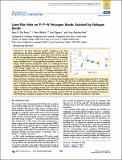Por favor, use este identificador para citar o enlazar a este item:
http://hdl.handle.net/10261/169572COMPARTIR / EXPORTAR:
 SHARE SHARE
 CORE
BASE CORE
BASE
|
|
| Visualizar otros formatos: MARC | Dublin Core | RDF | ORE | MODS | METS | DIDL | DATACITE | |

| Título: | Lone-Pair Hole on P: P···N Pnicogen Bonds Assisted by Halogen Bonds |
Autor: | Del Bene, Janet E.; Alkorta, Ibon CSIC ORCID ; Elguero, José CSIC ORCID; Sánchez-Sanz, Goar CSIC ORCID | Fecha de publicación: | 2017 | Editor: | American Chemical Society | Citación: | The journal of physical chemistry, A, Molecules, spectroscopy, kinetics, environment & general theory 121: 1362- 1370 (2017) | Resumen: | Ab initio MP2/aug'-cc-pVTZ calculations have been performed on the binary complexes XY:PH for XY = ClCl, FCl, and FBr; and PH:N-base for N-base = NCH, NH, NCF, NCCN, and N; and the corresponding ternary complexes XY:PH:N-base, to investigate P···N pnicogen bond formation through the lone-pair hole at P in the binary complexes and P···N pnicogen-bond formation assisted by P···Y halogen bond formation through the σ-hole at Y. Although the binary complexes PH:N-base that form through the lone-pair hole have very small binding energies, they are not equilibrium structures on their potential surfaces. The presence of the P···Y halogen bond makes PH a better electron-pair acceptor through its lone-pair hole, leading to stable ternary complexes XY:PH:N-base. The halogen bonds in ClCl:PH and ClCl:PH:NCCN are traditional halogen bonds, but in the remaining binary and ternary complexes, they are chlorine- or bromine-shared halogen bonds. For a given nitrogen base, the P···N pnicogen bond in the ternary complex FCl:PH:N-base appears to be stronger than that bond in FBr:PH:N-base, which is stronger than the P···N bond in the corresponding ClCl:PH:N-base complex. EOM-CCSD spin-spin coupling constants for the binary and ternary complexes with ClCl and FCl are also consistent with the changing nature of the halogen bonds in these complexes. At long P-Cl distances, the coupling constant J(P-Cl) increases with decreasing distance but then decreases as the P-Cl distance continues to decrease, and the halogen bonds become chlorine-shared bonds. At the shorter distances, J(P-Cl) approaches the value of J(P-Cl) for the cation (Cl-PH). The coupling constants J(P-N) are small and, with one exception, are greater in ClCl:PH:N-base complexes compared to that in FCl:PH:N-base, despite the shorter P-N distances in the latter. | Versión del editor: | http://dx.doi.org/10.1021/acs.jpca.6b12553 | URI: | http://hdl.handle.net/10261/169572 | DOI: | 10.1021/acs.jpca.6b12553 | Identificadores: | doi: 10.1021/acs.jpca.6b12553 issn: 1089-5639 e-issn: 1520-5215 |
| Aparece en las colecciones: | (IQM) Artículos (IIQ) Artículos |
Ficheros en este ítem:
| Fichero | Descripción | Tamaño | Formato | |
|---|---|---|---|---|
| acs.jpca.6b12553-1.pdf | 1,39 MB | Adobe PDF |  Visualizar/Abrir |
CORE Recommender
SCOPUSTM
Citations
32
checked on 06-abr-2024
WEB OF SCIENCETM
Citations
31
checked on 24-feb-2024
Page view(s)
272
checked on 18-abr-2024
Download(s)
234
checked on 18-abr-2024
Google ScholarTM
Check
Altmetric
Altmetric
NOTA: Los ítems de Digital.CSIC están protegidos por copyright, con todos los derechos reservados, a menos que se indique lo contrario.
